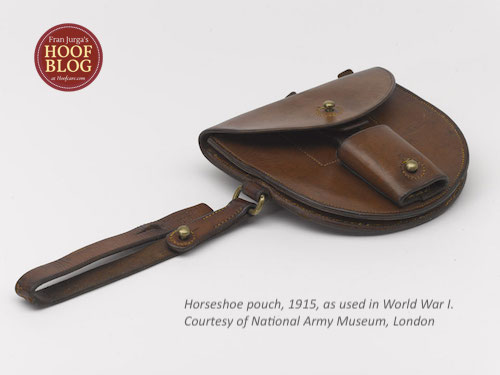And keep your eye on the bouncing horseshoe pouch.
 |
He's a British cavalry horse. It's World War I. He's lost his rider and he's behind German lines. The horse is running for his life, blindly through the forest.
Do you notice anything interesting about his tack?
Most people are arguing about whether the runaway scene through No Man's Land toward the end of the film (the one shown repeatedly on television trailers) was done with edited tack. Surely his stirrups were removed or they would have caught on something in all that debris the horse encountered. And a real horse would have stepped on his reins, they say.
But some of us were straining to see if the horseshoe pouch had found its way back to the saddle. This leather case was designed to carry two spare horseshoes and 12 nails. The case was attached to military saddles; every horse went forward with spare shoes and nails. And Steven Spielberg's crew was detail-oriented enough to make sure that the traditional pouch is attached to the saddle.
Horseshoe pouches can be pricey; Ken McPheeters' Antique Militaria has two American ones (one is shown below) for sale, one pre- and one post-Civil War. They start at $1000. There is a double pouch for shoes and brushes.
 |
| How considerate of the actor who played Captain Nicholls, Tom Hiddleston, to lift his arm and reveal the horseshoe pouch (circled) in this still image from the film. DreamWorks Pictures image. |
Horseshoe pouches can be pricey; Ken McPheeters' Antique Militaria has two American ones (one is shown below) for sale, one pre- and one post-Civil War. They start at $1000. There is a double pouch for shoes and brushes.
When you opened the case, this is what you would have seen (see photo): a small pocket for nails and usually two horseshoes. I think someone needs to make a nice horseshoe for this nice old case, unless maybe the old used shoe shown here has historical significance.
Some cases had a loop on the outside that held a saber where it would not impede the movement or comfort of the rider but where it could easily be reached and drawn. The pouch in War Horse did not have that loop, although the one in the photo from the National Army Museum does have it.
Throughout War Horse, the attention to detail in the uniforms and horse equipment is admirable. Once the horse goes to war, the experts were on the set. Of course, there are always disagreements about what is accurate, since there were so many variations over the course of history.
The horseshoe case was one little detail among many but it's an important one to get right. And they did.
Links to US military horseshoe pouches for sale by Ken McPheeters:
http://www.mcpheetersantiquemilitaria.com/04_horse_equip/04_item_022.htm
http://www.mcpheetersantiquemilitaria.com/04_horse_equip/04_item_012.htm
Some cases had a loop on the outside that held a saber where it would not impede the movement or comfort of the rider but where it could easily be reached and drawn. The pouch in War Horse did not have that loop, although the one in the photo from the National Army Museum does have it.
Throughout War Horse, the attention to detail in the uniforms and horse equipment is admirable. Once the horse goes to war, the experts were on the set. Of course, there are always disagreements about what is accurate, since there were so many variations over the course of history.
The horseshoe case was one little detail among many but it's an important one to get right. And they did.
TO LEARN MORE
Links to US military horseshoe pouches for sale by Ken McPheeters:
http://www.mcpheetersantiquemilitaria.com/04_horse_equip/04_item_022.htm
http://www.mcpheetersantiquemilitaria.com/04_horse_equip/04_item_012.htm
More about horseshoe pouches:
http://www.sportingcollection.com/blog/?p=222#comments
Much more about War Horse: Fran Jurga's War Horse News blog
Disclosure of Material Connection: I have not received any direct compensation for writing this post. I have no material connection to the brands, products, or services that I have mentioned, other than Hoofcare Publishing. I am disclosing this in accordance with the Federal Trade Commission’s 16 CFR, Part 255: Guides Concerning the Use of Endorsements and Testimonials in Advertising.
http://www.sportingcollection.com/blog/?p=222#comments
Much more about War Horse: Fran Jurga's War Horse News blog
 |
| Click here to add your email address to the Hoof Blog news list. |
Questions or problems with this blog? Send email to hoofblog@gmail.com.
Read more news on the Hoofcare + Lameness Facebook Page



























